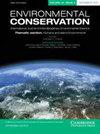济州岛联合国教科文组织遗产和生物圈地土地利用和生态系统服务的复杂时空变化(大韩民国)
IF 2.6
3区 环境科学与生态学
Q2 BIODIVERSITY CONSERVATION
引用次数: 2
摘要
被联合国教科文组织指定为世界遗产的济州岛继续面临着为地区旅游业和经济振兴目的而鲁莽开发的人为压力。由于土地利用/土地覆盖(LULC)影响生态系统服务和人类福祉,因此在长期分析的基础上全面确定LULC变化的原因至关重要。这项研究调查了1973年至2019年济州岛47年来的LULC变化,并量化了四种生态系统服务的变化:栖息地质量、碳储量、水量和累积视野。从1973年到1998年,林地从22%增加到56%,但这些恢复工作都是在草地上进行的,使土地类型从42%减少到17%。这一过程使栖息地质量最高的地区从68%增加到73%,碳储量从2000万吨增加到3000万吨。1998年至2009年间,耕地面积增加了一倍多,从21%增加到44%。因此,栖息地质量最高的地区从73%下降到49%,碳储量从300万吨下降到230万吨。我们的分析可以帮助利益相关者和政策制定者制定管理规划,并通过济州岛的恢复和保护政策改善生态系统服务。本文章由计算机程序翻译,如有差异,请以英文原文为准。
Complex spatiotemporal changes in land-use and ecosystem services in the Jeju Island UNESCO heritage and biosphere site (Republic of Korea)
Summary Jeju Island, designated by UNESCO as a world heritage site, continues to face the anthropogenic pressures of reckless development for regional tourism and economic revitalization purposes. Because land use/land cover (LULC) affects ecosystem services and human well-being, it is crucial to comprehensively identify the causes of changes in LULC based on long-term analyses. This study examined LULC changes on Jeju Island over 47 years from 1973 to 2019 and quantified changes in four ecosystem services: habitat quality, carbon stock, water yield and cumulative viewshed. From 1973 to 1998, forest land increased from 22% to 56%, but these restoration efforts were conducted in grassland, reducing that land type from 42% to 17%. This process increased the areas of highest habitat quality from 68% to 73%, and carbon stock increased from 20 to 30 million tonnes. Between 1998 and 2009, the area of cropland more than doubled from 21% to 44%. As a result, the areas of highest habitat quality decreased from 73% to 49%, and carbon stock decreased from 3.0 million tonnes to 2.3 million tonnes. Our analysis could help stakeholders and policymakers to develop their management planning and improve ecosystem services through restoration and conservation policies on Jeju Island.
求助全文
通过发布文献求助,成功后即可免费获取论文全文。
去求助
来源期刊

Environmental Conservation
环境科学-环境科学
CiteScore
5.20
自引率
3.70%
发文量
43
审稿时长
>36 weeks
期刊介绍:
Environmental Conservation is one of the longest-standing, most highly-cited of the interdisciplinary environmental science journals. It includes research papers, reports, comments, subject reviews, and book reviews addressing environmental policy, practice, and natural and social science of environmental concern at the global level, informed by rigorous local level case studies. The journal"s scope is very broad, including issues in human institutions, ecosystem change, resource utilisation, terrestrial biomes, aquatic systems, and coastal and land use management. Environmental Conservation is essential reading for all environmentalists, managers, consultants, agency workers and scientists wishing to keep abreast of current developments in environmental science.
 求助内容:
求助内容: 应助结果提醒方式:
应助结果提醒方式:


